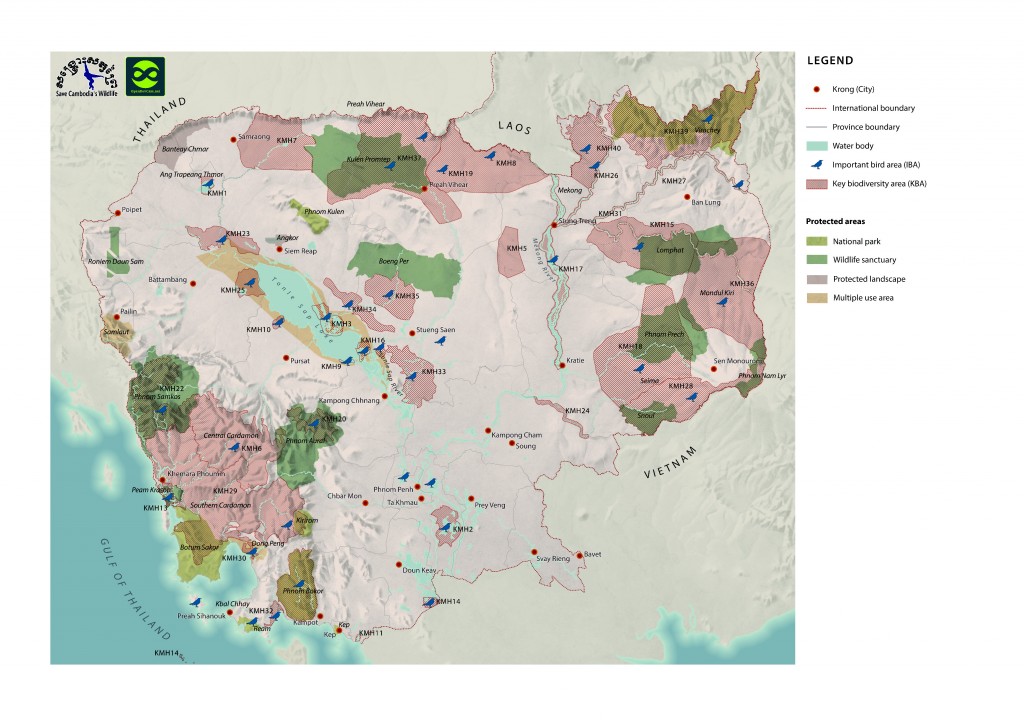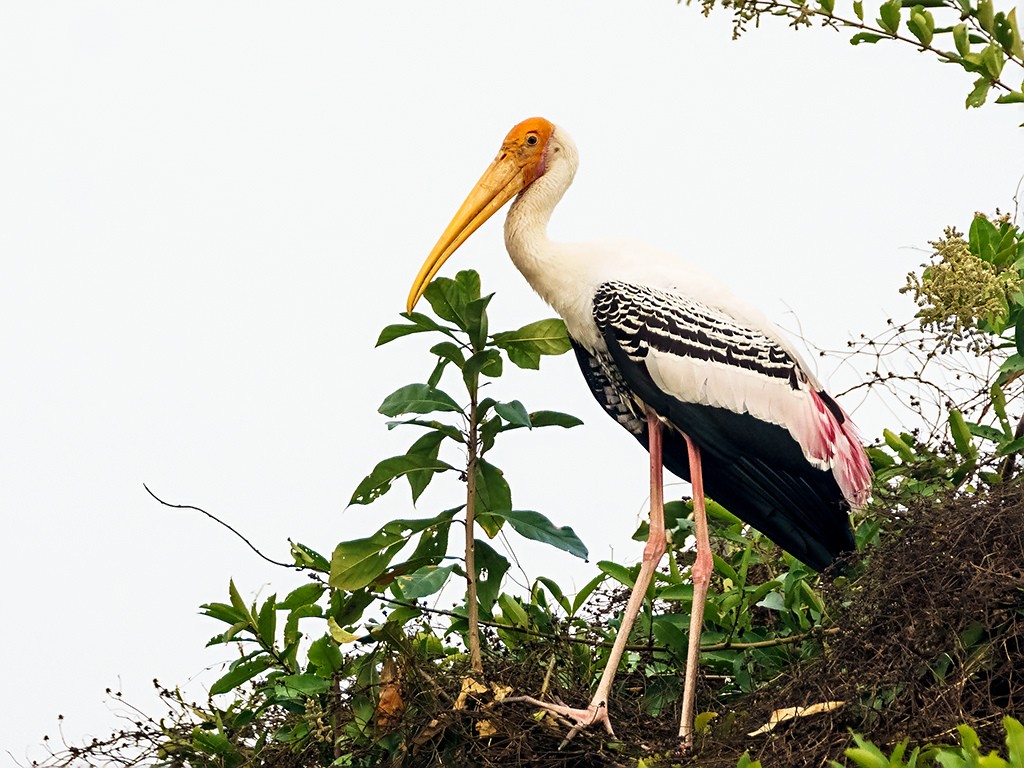ប្រទេសកម្ពុជា គឺជាប្រទេសមួយដែលសម្បូរទៅដោយជីវៈចម្រុះជាច្រើន ក្នុងចំណោមបណ្តាប្រទេសនានា នៅតំបន់អាស៊ីអាគ្នេយ៍។ ជីវៈចម្រុះ ជួយទ្រទ្រង់ដល់ប្រជាជនកម្ពុជា ទាំងផ្នែកបរិស្ថាន សេដ្ឋកិច្ច និង វប្បធម៌។ ជីវៈចម្រុះ មានតួនាទីយ៉ាងសំខាន់ក្នុងការផ្តល់នូវផលប្រយោជន៍ ប្រព័ន្ធអេកូឡូស៊ីដល់ មនុស្សជាតិ និងការអភិវឌ្ឍសេដ្ឋកិច្ច ដើម្បីឱ្យសម្រេចបាននូវ គោលដៅអភិវឌ្ឍន៍សហស្សវត្សរ៍កម្ពុជា ព្រមទាំងការកាត់បន្ថយភាពក្រីក្រផងដែរ។
តំបន់អភិរក្សសត្វស្លាបព្រែកទាល់ បឹងទន្លេសាប ខេត្តសៀមរាប ប្រទេសកម្ពុជា។ រូបភាព ថតដោយ David Cook, ១៥ កុម្ភះ ២០១៥។ ក្រោមអាជ្ញាប័ណ្ណ CC BY-NC 2.0។
ស្ថានភាពបច្ចុប្បន្ននៃជីវៈចម្រុះនៅកម្ពុជា
យោងតាម របាយការណ៍ថ្នាក់ជាតិស្តីពីតំបន់ការពារ និងការអភិវឌ្ឍរបស់ប្រទេសកម្ពុជា តំបន់គ្រប់គ្រង ជីវចម្រុះចំនួនប្រាំពីរនៅទូទាំងប្រទេស មានដូចជា (១) តំបន់ឆ្នេរ និងទឹកសមុទ្រភាគនិរតី, (២) តំបន់ ទំនាបភាគខាងជើង, (៣) ព្រៃឈើនៅភាគឦសាន, (៤) ខេត្តកំពង់ចាម, (៥) តំបន់ដីសណ្ដទន្លេមេគង្គ, (៦) វាលទំនាបលិចទឹកទន្លេសាប, និង (៧) តំបន់នៅភាគពាយព្យ។1
ព្រះរាជាណាចក្រកម្ពុជា ជាជម្រកសម្រាប់ ថនិកសត្វច្រើនជាង ១៣៥ប្រភេទ, សត្វបក្សី ៥៩៩ប្រភេទ, សត្វល្មូន ១៧៣ប្រភេទ, ថលជលិកសត្វ ៧២ប្រភេទ, រេណុប្បត្ថសត្វ និងសត្វមេអំបៅ ៣៥០ប្រភេទ, ពពួកមច្ឆាទឹកសាប និងទឹកប្រៃ និងប្រភេទសត្វរស់នៅក្នុងទឹក ៣៥០ប្រភេទ និង រុក្ខជាតិសរសៃ ៤៥០០ប្រភេទ។ នេះបើយោង តាមរបាយការណ៍ជាតិលើកទីប្រាំ នៃអនុសញ្ញាស្តីពីជីវៈចម្រុះនៅឆ្នាំ ២០១៤។2

តំបន់ជីវៈចម្រុះ និងសត្វស្លាបសំខាន់ៗនៅកម្ពុជា។ អាត់ឡាសកម្ពុជា ឆ្នាំ២០១៣, អង្គការសង្គ្រោះសត្វព្រៃកម្ពុជា, កំណៃទី២។
កិច្ចផ្តួចផ្តើមថ្នាក់ជាតិ និងអន្តរជាតិ
ការបង្កើតតំបន់ការពារ គឺមិនត្រឹមតែមានសារៈសំខាន់ក្នុងការអភិរក្សជីវៈចម្រុះនៅកម្រិតថ្នាក់ជាតិ ប៉ុណ្ណោះទេ ប៉ុន្តែក៏មានសារៈសំខាន់ជាលក្ខណៈអន្តរជាតិផងដែរ សម្រាប់ការគ្រប់គ្រងនិងការអភិរក្ស នូវគុណតម្លៃផ្នែកធម្មជាតិ និងវប្បធម៌ និងការសម្រេចបាននូវការគ្រប់គ្រងរយៈពេលវែង នៃផលប្រយោជន៍ នានាដែលទទួលបាន ប្រព័ន្ធអេកូឡូស៊ីផងដែរ។
តួនាទីនៃតំបន់ការពារ កាន់តែមានសារៈសំខាន់ខ្លាំងឡើងៗគួរឱ្យកត់សម្គាល់ ក្នុងកិច្ចការងារគ្រប់គ្រង និងការអភិវឌ្ឍការការពារបរិស្ថាន និងជីវៈចម្រុះ នៅក្នុងប្រទេសកម្ពុជា។ ព្រះរាជក្រឹត្យស្តីពីការបង្កើត និងការរៀបចំតំបន់ការពារ បានបង្កើតឡើងនូវតំបន់ការពារចំនួន ២៣ កន្លែង នៅក្នុងឆ្នាំ ១៩៩៣ ដោយគ្របដណ្តប់លើផ្ទៃដីប្រមាណជា ៣,២៧៣,៣០០ ហិកតា ទូទាំងប្រទេស ដែលស្ថិតនៅក្រោម យុត្តាធិការនៃក្រសួងបរិស្ថាន។3
គួរកត់សម្គាល់ផងដែរថា ប្រទេសកម្ពុជា មានតំបន់រ៉ាមសា ៤កន្លែង ដែលត្រូវបានកំណត់ថា ជាតំបន់ ដីសើមសំខាន់ជាអន្តរជាតិ ដោយមានផ្ទៃដីសរុបចំនួន ៧៥,៩៤២ ហិកតា។4
រាជរដ្ឋាភិបាលកម្ពុជា បានបង្កើតនូវផែនការយុទ្ធសាស្ដ្រ និងសកម្មភាពថ្នាក់ជាតិស្តីពីជីវៈចម្រុះ នៅឆ្នាំ ២០០២ ដើម្បីអភិរក្សជីវៈចម្រុះ គ្រប់គ្រងសកម្មភាពនានារបស់មនុស្ស ប្រើប្រាស់ធនធានជីវៈចម្រុះប្រកប ដោយនិរន្តរភាព និងធានាឱ្យបាននូវការប្រើប្រាស់នៃធនធានជីវៈចម្រុះដែលរួមចំណែកដល់ការកាត់បន្ថយ ភាពក្រីក្រ។5
រាជរដ្ឋាភិបាលបានបោះជំហានឆ្ពោះទៅមុខ ជាមួយនឹងការប្តេជ្ញាចិត្តដើម្បីធ្វើឱ្យមាននិរន្តរភាពនៃការ ប្រើប្រាស់បរិស្ថាន និងជីវៈចម្រុះ តាមរយៈការចុះហត្ថលេខាលើអនុសញ្ញាអន្តរជាតិជាច្រើន រួមមាន៖
- អនុសញ្ញាស្តីពីជីវៈចម្រុះ
- អនុសញ្ញាស្តីពីការប្រែប្រួលអាកាសធាតុ
- អនុសញ្ញាស្តីពីតំបន់ដីសើមដែលមានសារៈសំខាន់ជាអន្តរជាតិ (អនុសញ្ញារ៉ាមសារ)
- អនុសញ្ញាស្តីពីពាណិជ្ជកម្មអន្តរជាតិទៅលើសត្វព្រៃជិតផុតពូជ (ហៅកាត់ថា CITES)
- អនុសញ្ញាបេតិកភណ្ឌពិភពលោក
- អនុសញ្ញាអង្គការសហប្រជាជាតិស្តីពីច្បាប់សមុទ្រ
- អនុសញ្ញាអន្តរជាតិសម្រាប់ការទប់ស្កាត់ការបំពុលពីនាវា
- កិច្ចព្រមព្រៀងស្តីពីកិច្ចសហប្រតិបត្តិការសម្រាប់ការអភិវឌ្ឍប្រកបដោយនិរន្តរភាពនៃអាងទន្លេមេគង្គ6
និន្នាការថ្មីៗ
ដោយសារកម្ពុជា ជាប្រទេសកំពុងអភិវឌ្ឍន៍ ហេតុនេះការអភិវឌ្ឍសេដ្ឋកិច្ច និងសង្គម ពឹងផ្អែកយ៉ាងខ្លាំង ទៅលើការប្រើប្រាស់ធនធានធម្មជាតិ។ តុល្យភាពរវាងតម្រូវការនៃការអភិវឌ្ឍសេដ្ឋកិច្ច និងការប្រើប្រាស់ ធនធានធម្មជាតិដែលប្រកបដោយចីរភាព នៅតែជាបញ្ហាចម្បងសម្រាប់រាជរដ្ឋាភិបាលកម្ពុជា។
ការកាប់បំផ្លាញព្រៃឈើ និងការទន្រ្ទានសម្រាប់វិស័យកសិកម្ម ជាបញ្ហាប្រឈមទូទៅបំផុត ក្នុងការការពារ ជីវៈចម្រុះ នៅកម្ពុជា។ ការកើនឡើងនូវការវិនិយោគដីសម្បទានសេដ្ឋកិច្ច ការពង្រីកដីកសិកម្មនិង ប្រពលវប្បកម្ម ការកាប់ឈើ ការអភិវឌ្ឍលើការរុករករ៉ែ និងទំនប់វារីអគ្គិសនី គឺជាកត្តាគំរាមកំហែង យ៉ាងខ្លាំង ដែលធ្វើឱ្យប៉ះពាល់ដល់ជីវៈចម្រុះ ជាពិសេសប្រភេទសត្វដែលជិតផុតពូជ។
សំណុំទិន្នន័យបច្ចុប្បន្នអំពី គម្របព្រៃឈើឆ្នាំ២០១៤, តំបន់ការពារ, តំបន់ព្រៃការពារ និងជលផល អាចរកបាននៅលើគេហទំព័រ អង្គការទិន្នន័យអំពីការអភិវឌ្ឍ (ODC)។ ទោះជាយ៉ាងណា ទិន្នន័យ និងព័ត៌មានស្តីពីស្ថានភាព និងនិន្នាការអំពីសត្វព្រៃ គឺនៅមានកង្វះខាតនៅឡើយ។
បានធ្វើបច្ចុប្បន្នភាព៖ ២៥ កញ្ញា ២០១៧
ទាក់ទងនឹងការការពារបរិស្ថាន និងជីវៈចម្រុះ
ឯកសារយោង
- 1. អង្គការ ICEM, ២០០៣. របាយការណ៍ថ្នាក់ជាតិកម្ពុជាស្តីពីតំបន់ការពារនិងការអភិវឌ្ឍ. ការពិនិត្យឡើងវិញនូវការអភិវឌ្ឍ និងតំបន់ការពារនៅតំបន់ទន្លេមេគង្គក្រោម, Indooroopilly, Queensland, Australia. 148 pp.
- 2. គណៈកម្មាធិការដឹកនាំថ្នាក់ជាតិស្តីពីជីវៈចម្រុះ, ក្រសួងបរិស្ថាន. របាយការណ៍ថ្នាក់ជាតិលើអនុសញ្ញាស្តីពីជីវៈចម្រុះលើកទីប្រាំ. ភ្នំពេញ៖ ២០១៤. ដកស្រង់ ២០ ឧសភា ២០១៥. https://www.cbd.int/doc/world/kh/kh-nr-05-en.pdf
- 3. ព្រះរាជក្រឹត្យស្តីពីការបង្កើតតំបន់ការពារ, ឆ្នាំ១៩៩៣
- 4. គេហទំព័ររ៉ាមសា ឆ្នាំ២០១៧។ ចូលអានថ្ងៃទី ២៥ ខែកញ្ញា ឆ្នាំ ២០១៧។ http://www.ramsar.org/wetland/cambodia
- 5. ដូចលេខយោងខាងលើ។
- 6. ក្រសួងបរិស្ថាន. ផែនការសកម្មភាព និងយុទ្ធសាស្ត្រជីវៈចម្រុះថ្នាក់ជាតិ. ភ្នំពេញ៖ ២០០២. ដកស្រង់ ១០ ឧសភា ២០១៥. https://www.cbd.int/doc/world/kh/kh-nbsap-01-en.pdf


